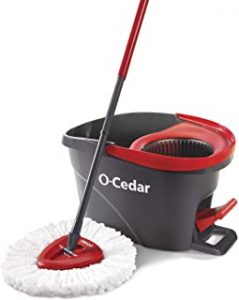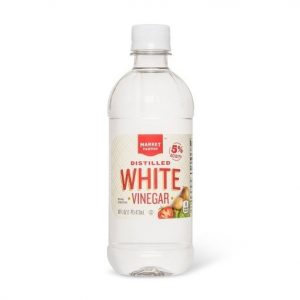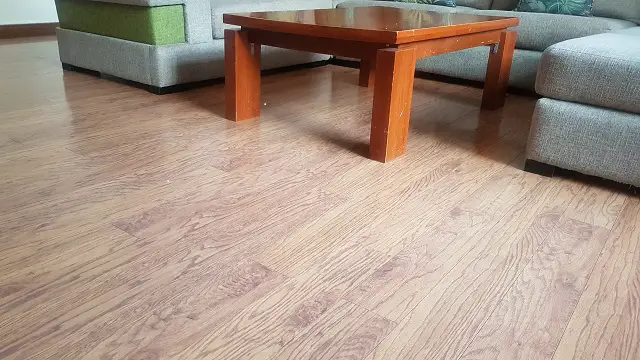Your laminate kitchen floor, like anything else in your home that gets a lot of use, needs to be cleaned on a regular basis to avoid looking dusty and worn out.
Actually, if laminate kitchen floors aren’t cleaned on a regular basis, dirt can become trapped between the seams, or they might develop cracks.
Due to dirt or streaks of soap residues being prone to emerging on their shiny surface even after washing, laminate kitchen flooring is quickly soiled. However, having a spotless, clean floor isn’t impossible with a laminated surface.
Vacuum or sweep the floor on a regular basis to eliminate all dirt and grime. Grit is laminate flooring’s worst enemy, as it often scratches the surface. It is best to clean the floor carefully when dealing with grime, grit, or other abrasive dirt.
No products found.
Cleaning laminate kitchen floors is a breeze if you have the correct tools. Before you start cleaning your laminate floors, keep these easy tips in mind:
- Never vacuum your laminate floor since it will scratch it (soft, handheld attachments are fine).
- Do not steam the floor with a steamer (it creates almost impossible spots to get rid of).
- Do not use harsh soaps or items containing harsh or abrasive soaps on the laminate.
Simple Methods for Cleaning Laminate Kitchen Floors
Laminate flooring requires extra care while cleaning since it is vulnerable to damage from scrubbing methods or harsh cleaners. Easy ways to clean laminate kitchen floors without harming them include:
-
Using soaps to clean
You should clean your laminate kitchen floor with soap and water on a regular basis to keep it looking new.
What You’ll Require
- Sponge or dry cloth
- Baby shampoo or mild liquid detergent
- A bucket of hot water and a mop
Instructions for cleaning laminate floors with mild soap
To safely clean your laminate kitchen floors with soap, follow these instructions:
- Fill the bucket halfway with warm water and add 2 tablespoons of baby shampoo or mild detergent. Dyed or perfumed detergents are more likely to leave stains behind. Baby shampoos are also good, so stay away from adult shampoos.
- Stir the liquid soap into the water until it is completely dissolved. After that, soak the mop in water and wring it out until it’s wet but drenched.
- You should mop the kitchen floor in the direction of the grains, using back and forth strokes. Begin at one end of the room and work your way to the exit.
- Clean the residual soap water off the kitchen floor with a dry cloth if it feels wet and slippery. Wipe the area again with a mop dipped in plain water to remove any residual soap.
- Using soap water to clean floors with large spills or built-up stains over time, such as sweet liquids, is a terrific idea.
If you want to extend the life of your laminate kitchen floor, keep it clear of dampness, grit, and dust. Maintain its luster and sparkle by washing it on a regular basis.
Here are some general recommendations that you should keep in mind regularly.

- Use a laminate friendly steam mop or a commercial laminate kitchen floor cleaner for deep cleaning on a regular basis. Before completing a deep clean, ensure that you read the manufacturer’s care directions. Take note that not all steam mops are appropriate for use on laminates.
- Clean grease and dirt using a slightly wet mop. When cleaning, ensure that you use one bucket for the soapy soiled water and another one for the clean water for rinsing. This is to avoid repeating a soiled mop head, which could result in streaks on the floor surface. When cleaning a laminate kitchen floor, avoid using an extremely wet mop to avoid damage to the floor when water seeps inside the baseboards.
- Sweep the same direction that the floor is placed, whether you use a vacuum or dry mop. While sweeping, this will help you prevent dust from gathering in the spaces between interlocking parts.
- To remove dust particles, use a soft dry dust mop to sweep the kitchen floor. Because it can scrape and damage the surface of the laminate kitchen floor, the job is not for a traditional broom. In addition, a wet mop is ineffective at removing dust particles. The reason is that it leaves streaks and residues on the floor. To clear dust from your laminate kitchen floor, use a brush roll button or a vacuum cleaner with a hard floor setting.
-
Cleaning with hot water
One of the best ways to clean laminate kitchen floors on a regular basis is by using hot water. The water doesn’t have to be boiling; a little hotter or lukewarm would do. When you have stubborn stains that cannot be removed with cold water, hot water cleaning is especially helpful.
What You’ll Require

- A bucket of hot water
- A wet mop
- Gentle detergent
- Use a dry mop
Instructions for cleaning laminates with hot water
- Sweep the floor with a dry mop before doing a wet mop sweep with hot water. This will help remove any debris and dust that may have become attached to the kitchen floor after the wet sweep.
- It is best to soak the damp mop in hot water and wring it out until it’s damp but not drenched. Use a back-and-forth motion to mop the kitchen floor, following the grain direction. Sweeping it from side to side perpendicular to the grains is not a good idea.
- Begin mopping in the middle of the kitchen floor and work your way outwards. You’ll have to walk back on the newly mopped kitchen floor if you start from the outside in.
- Make sure the mop isn’t soaking wet, so there aren’t any water puddles when you’re done.
- If the floor is only slightly damp, let it air dry. Mop it up with a dry cloth if it gets a bit moist.
- If there are stubborn stains, mix with a small amount of mild detergent for extra cleaning strength.
No products found.
-
Cleaning laminate kitchen floors regularly
There are guidelines for cleaning the laminate kitchen floors on your frequent maintenance schedule or regular days.
What You’ll Require
- Soft brush attachments for vacuum cleaners
- Gentle Detergent without harsh chemicals
- Sponge or microfiber cleaning cloth
- Dry dust mop with soft bristles
- Cleaning mop made of soft cloth
Instructions for regular cleaning of laminate floors
The following are instructions for cleaning your laminate kitchen floors:
Sweeping:
To keep out pet hair and dust, and maybe prevent allergies, it is best to sweep the laminate floor on a regular basis. Though the floors are rather durable, extra grime and debris can accumulate over time and scrape the surface as you walk. You can avoid scratches by sweeping regularly. Use a mop with soft bristles to dry dust or sweep the floor using a soft brush vacuum.
Spill Cleanup:
You should clean up any spills before they discolor the kitchen floor. To get the most out of a microfiber cloth, absorb the spill with it and wipe in the direction of the grain. To eliminate any remaining spills, it is best to dampen a second cloth and wipe it down.
Deep Cleaning:
To deep clean a laminate kitchen floor, it is best to mop. You should not use polishers, buffers, and steam cleaners since they can weaken the laminate over time.
Stronger cleaning:
To remove stubborn dirt and stains attached to the kitchen floor, use vinegar, or a light detergent.
-
Use a vinegar solution

Vinegar is a great acidic cleaner that’s gentle on all surfaces and good at disinfecting laminate kitchen floors.
What You’ll Require
- Vinegar
- A cleaning sponge or microfiber cloth
- Spray bottle
- Water
Instructions on how to clean laminate floors with vinegar
How to clean laminate kitchen floors with a vinegar solution is as follows:
- Vinegar in its natural state is far too harsh to use. As a result, you’ll need to dilute it before you make use of it. Mix 1-liter of water with 60 ml of vinegar in a big spray container to make the spraying solution. Mix 3 squirts of liquid detergent with 80ml of vinegar in four liters of warm water. This will make a stronger cleaning liquid.
- Begin cleaning at one end of the room, spraying only a tiny portion of the kitchen floor so that you can use a dry microfiber cloth to wipe it clean speedily. Spraying the entire kitchen floor at once is not recommended since the solution will dry before you reach it.
- To clean the laminated kitchen floor, wipe it gently with a soft microfiber cloth. It is best to avoid using mops and other abrasive cleaners.
- If there’s any remaining water, absorb it completely with a dry cloth. Allowing any water to sit in a puddle is not a good idea.
- Wipe with a moist cloth soaked in plain water and wrung a second time if necessary.
Stain removal on laminate floors
Depending on the type of stain, there are some basic cleaning techniques that you can use to remove it.
- Wipe wine and ink stains with a towel dampened in warm water and detergent solution. If this fails, use a commercial ink remover to remove the ink stain or use denatured alcohol to remove the wine stain.
- To get rid of the grease stain, add an ice pack to it first to solidify the grease. Using a plastic knife, gently scrape away the solidified grease. To make wiping the residue easier, spray it with window cleaner.
- Before removing chewing gum, scrape it off with a plastic knife. After that, use a wet cloth immersed in mineral spirits to scrub the residue away until it is gone.
- To remove crayon marks, use a dry cloth soaked in toothpaste or a soft, damp cloth soaked in mineral spirits.
Laminate floors are great for people searching for a stylish and cost-effective flooring choice. The floor will stay for years when you follow the proper cleaning and maintenance methods.
If you clean and maintain your laminate kitchen floor properly, you’ll have a gorgeous finish for many years.

